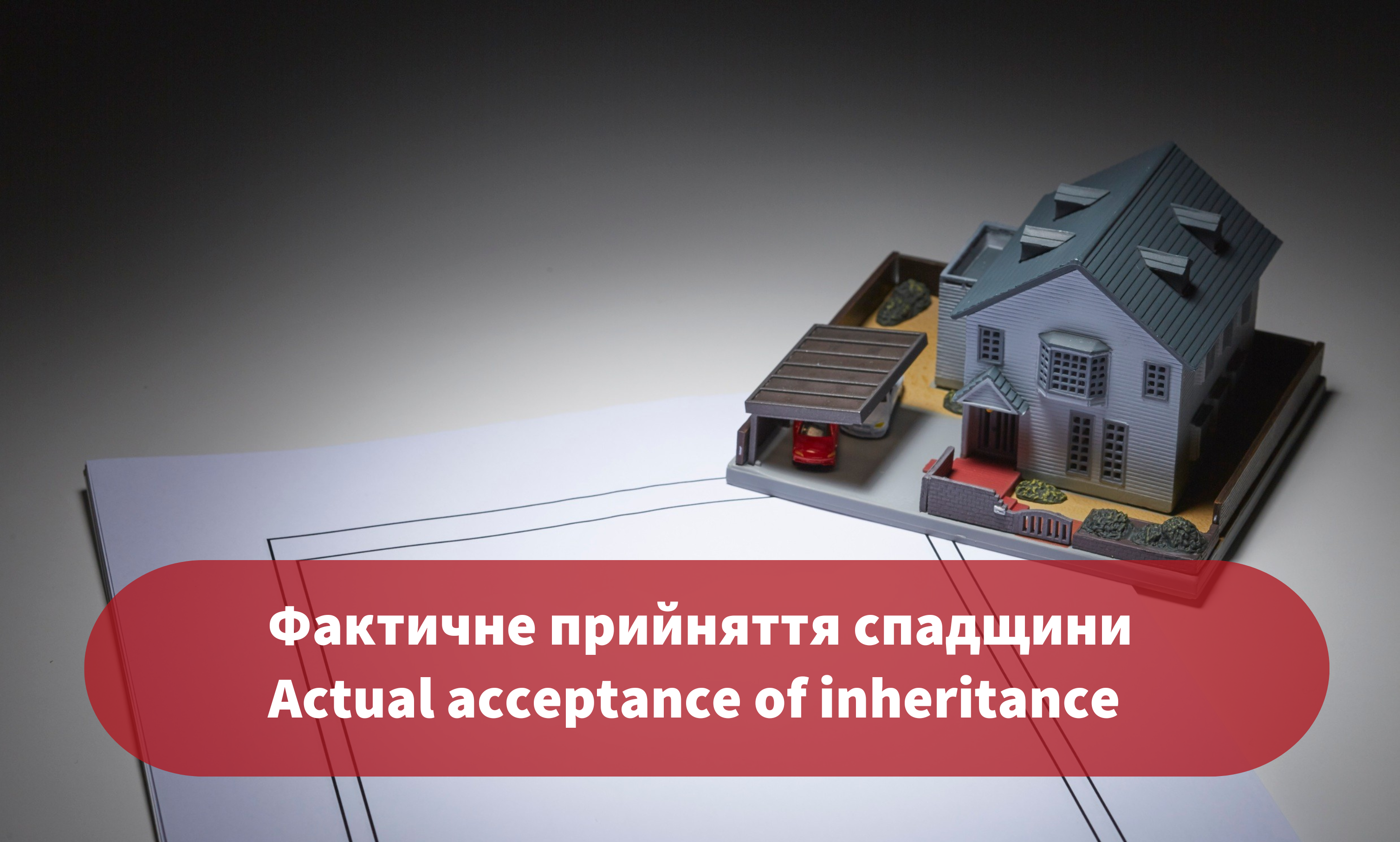Actual acceptance of inheritance
After the death of a loved one, the issue of inheritance arises almost immediately. Often, heirs do not rush to the notary but begin to use the deceased’s property — they live in their house, take care of the household, pay utility bills or taxes. In such cases, this is referred to as actual acceptance of inheritance. This way of acquiring inheritance rights is provided for by the Civil Code of Ukraine and has important practical significance, as an heir may be deemed to have accepted the inheritance even without submitting an official application to the notary.
What is actual acceptance of inheritance?
Actual acceptance of inheritance occurs when an heir fails to submit a formal statement to the notary within the six-month period established by law (from the date of the testator’s death) but confirms through their actions that they have accepted the inheritance.
It is also considered actual acceptance when an heir who permanently lived with the deceased at the time of death did not refuse the inheritance by a notarized declaration (Articles 1268, 1270 of the Civil Code of Ukraine).
Actual acceptance of inheritance is carried out by heirs of the succession order that has the right to inherit at the time of the testator’s death. This means — heirs of the first order, if any exist. If they are absent or do not accept the inheritance — heirs of the next order are entitled.
Under Ukrainian law, there are five orders of heirs by law, depending on the degree of kinship:
First order — children, spouse of the deceased, and parents.
Second order — siblings, grandparents.
Third order — uncles and aunts.
Fourth order — persons who lived as one family with the deceased for at least five years before the opening of the inheritance.
Fifth order — other relatives up to the sixth degree of kinship, as well as dependents of the deceased who were not family members.
Do you need to visit a notary if you have actually accepted the inheritance?
Inheritance rights must be officially formalized by a state or private notary, to whom one can apply in any locality within the territory controlled by Ukraine. Under martial law, the principle of extraterritoriality applies — meaning that a notary anywhere in Ukraine can open an inheritance case, regardless of the place where the inheritance is opened.
Usually, the heir contacts the notary twice. First — with an application for acceptance of the inheritance within six months from the date of the testator’s death. Second — to obtain a certificate of inheritance rights. There is no time limit for the second visit.
Heirs who lived together with the deceased and actually accepted the inheritance may skip the first step and directly apply for a certificate of inheritance rights.
However, it is strongly advised not to rely solely on actual acceptance and to submit a formal application for inheritance within six months.
When must actual acceptance of inheritance be proven?
If the heir failed to apply to a notary within the statutory time, they must provide evidence of actual acceptance and/or cohabitation with the deceased at the time of death to obtain a certificate of inheritance rights.
- The law establishes a six-month period from the date of the testator’s death during which the heir must apply to the notary with a statement of inheritance acceptance. This is a mandatory condition for obtaining a certificate of inheritance rights in the future.
- If you did not apply to the notary within this period but actually accepted the inheritance — for example, lived in the deceased’s home, paid utility bills, or maintained the property in good condition — these actions may confirm your acceptance. However, without supporting evidence (official documents), the notary has no legal grounds to issue a certificate of inheritance rights and must refuse to perform the notarial act.
If the notary refuses to issue the certificate of inheritance rights, the heir must apply to the court with a claim to establish the fact of cohabitation with the deceased or to recognize ownership rights to the inherited property.
If there is a dispute between heirs that cannot be resolved out of court, it will also need to be settled through the court by recognizing ownership rights to the inheritance property.
Which actions are considered proof of inheritance acceptance?
1.Living in the inherited property:
- if the heir was registered and actually lived in the testator’s home at the time of death;
- continued to reside there after the testator’s death;
- takes care of the property, protects it, or carries out repairs.
2. Payment of expenses related to the inherited property:
- payment of utility bills;
- payment of land or real estate taxes;
- repayment of the testator’s loan, debt, or credit obligations.
3.Maintenance and preservation of the property:
- carrying out repairs of the inherited property;
- signing a security or maintenance contract;
- paying expenses for the safekeeping of items (for example, a car).
4.Use of inherited property:
- using the deceased’s vehicle;
- cultivating the land plot and collecting the harvest;
- renting out an apartment or other real estate.
5.Receiving income or payments belonging to the deceased:
- receiving rental payments or other income that belonged to the deceased.
6.Preservation and disposal of the deceased’s property:
- keeping personal belongings, valuables, and documents;
- preserving inherited property from damage or loss;
- taking actions to dispose of the property (for example, selling livestock that belonged to the deceased).
7.Managing the deceased’s affairs:
- contacting institutions or organizations on behalf of the deceased;
- paying the deceased’s debts using their property.
Important: The law does not define an exhaustive list of such actions — the court evaluates each case individually, considering any actions that demonstrate that the heir accepted the property as their own. Evidence may include receipts, contracts, certificates, witness testimonies, or official acts of local authorities.
Is it possible to refuse an inheritance after it has been actually accepted?
The law grants an heir the right to refuse an inheritance within the period established for its acceptance, that is, within six months from the date of the testator’s death.
If the inheritance has already been actually accepted, this legally means that you have already become an heir. In such a case, refusal of the inheritance is impossible, because through your actions you have clearly demonstrated the intent to accept it.
Therefore, an inheritance may be refused only within the six-month period and only before you have performed any actions — or omissions (such as residing in the property or maintaining it) — that indicate actual acceptance.
What to do if the inheritance acceptance period has been missed?
For detailed guidance on what to do if a notary refuses to formalize inheritance due to a missed deadline, read the article “How to formalize inheritance in case of missing the time limit for acceptance”.
Step-by-step algorithm for formalizing actual acceptance of inheritance
Step 1. Confirm the fact of the testator’s death.
- Obtain a death certificate from the Civil Status Registration Office (DRACS). Without this document, inheritance formalization is impossible.
Step 2. Prove the fact of cohabitation.
You must confirm that you permanently lived with the testator:
- a certificate from the CNAP/village council/housing office/HOA confirming registration at the same address;
- an extract from the territorial community register indicating the place of residence;
- if obtaining such a certificate is impossible — file an application with the court to establish the fact of cohabitation with the testator.
Step 3. Apply to the notary with a statement.
Within six months from the date of the testator’s death, the heir must personally submit a statement of inheritance acceptance to a notary.
Submitting this statement serves as a legal confirmation of the heir’s intention to accept the inheritance and formalize inheritance rights.
It is strongly recommended not to skip this step, even if there are signs of actual inheritance acceptance.
Step 4. Submit the necessary documents.
The following documents must be submitted to the notary:
- heir’s passport and tax identification code;
- death certificate;
- documents confirming family relations (birth certificate, marriage certificate, etc.);
- certificates or extracts proving cohabitation;
- property documents (ownership certificates, registry extracts, state land deeds, etc.).
Step 5. Obtain a certificate of inheritance rights.
After the six-month period, the notary issues a certificate of inheritance rights.
To manage inherited property — including donation, sale, or claiming compensation for damaged property — notarial formalization of inheritance is required.
If you have additional questions or need legal advice regarding inheritance acceptance, you can book an online consultation with a lawyer on the PravoVsim platform.
This informational material was created within the framework of a project implemented by Charitable Foundation “Caritas Mariupol” in cooperation with the Danish Refugee Council (DRC) and funded by the European Union’s Civil Protection and Humanitarian Aid Operations. The views and opinions expressed are those of the author(s) and do not necessarily reflect the views of the European Union or the DRC. Neither the European Commission nor the DRC can be held responsible for the content of this material.

